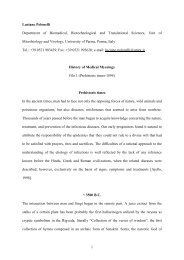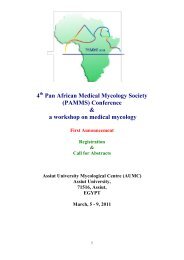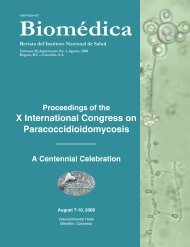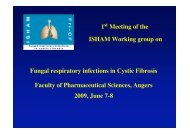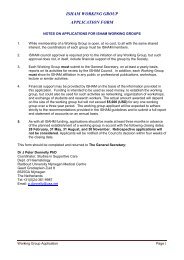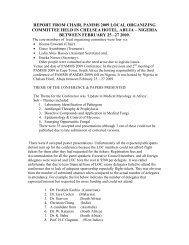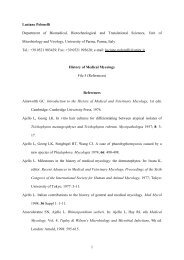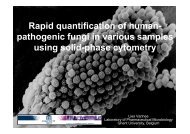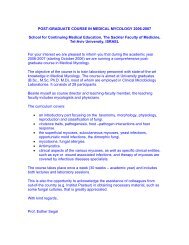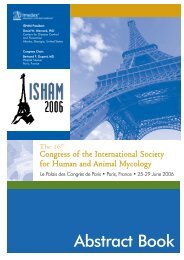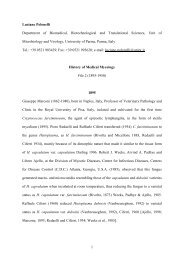Abstract book 2011 - ISHAM
Abstract book 2011 - ISHAM
Abstract book 2011 - ISHAM
Create successful ePaper yourself
Turn your PDF publications into a flip-book with our unique Google optimized e-Paper software.
CLINICAL AND MICROBIOLOGICAL EFFICACY OF MICAFUNGIN ONGEOSMITHIA ARGILLACEA INFECTION IN A FRENCH CYSTIC FIBROSISPATIENTLoïc Favennec 1 , Laure Couderc 1 , Olivier Mattray 1 , Sandrine Giraud 2 , RachidZouhair 2 , Sébastien Bertout 3 , Gilles Gargala 1 , Christophe Marguet 1 and Jean-Philippe Bouchara 21 University hospital and University of Rouen, 76031 Rouen France2 GEIHP, UPRES-EA 3142, Université d'Angers, Angers, France3 UMR 145 (IRD/UM1), UFR sciences pharmaceutiques et biologiques, 15, avenue Charles-Flahault, BP 14491, 34093 Montpellier cedex 5, FranceCystic fibrosis are at risk of colonization by a number of fungi, including Geosmithiaargillacea which appears to be an emerging pathogen in these patients. This pathogen hasbeen recently reported as a cause of invasive/systemic mycosis in immunocompromizedpatients such as colonized patients who are immunosuppressed for lung transplantation. Inthis context, we report here a case of clinical and microbiological efficacy of micafungin in aFrench cystic fibrosis patient chronically colonized with G. argillacea.O.D., a female F508Del-CFTR homozygous patient was diagnosed at birth with cysticfibrosis in January 1996. She was found chronically colonised with multi-resistantStaphylococcus aureus (MRSA) from 1997 to <strong>2011</strong>, and with Aspergillus fumigatus from2001 to 2006. She was treated alternatively with oral voriconazole and itraconazole from2004 to 2008, and with posaconazole since february 2008. Geosmithia argillacea was firstdiagnosed in May 2007, and chronic colonisation was persistent from this date to August2010 with 23/28 fungus positive sputum samples, in spite of posaconazole therapy. For anisolate obtained in October 2008, minimal inhibitory/effective concentrations (MIC/MEC,mg/ml) determined using the Eucast method were 2.0, 2.0, 16.0, 2,0, 0.25 and 0.015 foramphotericin B, itraconazole, voriconazole, posaconazole, caspofungin and micafungin,respectively. The FEV1 predicted value was 73% at the time of first fungus isolation and wasdecreased to 47% in October 2009. She then was given caspofungin for 21 days ((70 mg/day,later reduced to 50 mg) which resulted in clinical improvement (FEV1 = 64% in January2010) without eradication of G. argillacea. In June 2010, treatment with micafungin (75 mg,21days) was realized owing to deterioration of the respiratory function (FEV1 = 56%),withoutclinical improvement ( FEV1 = 47% in August 2010). O.D. was then treated from September,23 to November 3, 2010 with micafungin (100mg bid for 21 days and 100mg/day for thefollowing 21 days) which resulted in clinical and microbiological improvement. FEV1predicted ranged 67-68% in October and December 2010, and February and May <strong>2011</strong>, andfrom the end of treatment to December 2010, 5/6 sputum samples were found negative for G.argillacea. The positive sample contained fungus of the same genotype as previous isolates.The present case is to our knowledge the first description of G. argillacea eradication in achronically colonized cystic fibrosis patient. Similar to previous studies, G. argillaceacolonization was detected in the presence of chronic MRSA after A. fumigatus eradication.Since no change in bacterial colonization was observed before, during, and after G. argillaceacolonization, the present case is consistent with a pathogenic role of the fungus in cysticfibrosis patients. In vitro antifungal susceptibility assays suggested that echinocandins aremost effective agents against this fungus with a lowest MEC for micafungin (7 isolatesstudied, MEC range: 0.015-0.03), although eradication could only be obtained with high dosemicafungin for a long time (6 weeks).



